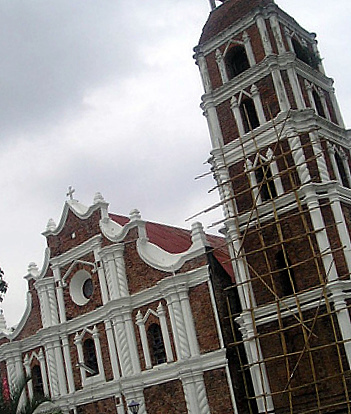
The first Spanish to set foot in what is now the town of Lal-lo is Juan de Salcedo --- Miguel Lopez de Legazpi’s grandson --- in 1572. Don Juan Pablo Carrion established it as a pueblo in 1581 and named it Nueva Segovia in memory of his hometown in Spain,. In 1595, Pope Clement VIII created the Diocese of Nueva Segovia and in 1596, the Dominicans accepted it as an ecclesiastical mission. Nueva Segovia had three churches: the cathedral that was under the secular clergy, and the parishes of Bagumbayan and Tocolona under the supervision of the Dominicans. But because of its distance from Manila and the constant threat of the Cagayan River’s rampaging waters, the Diocese of Nueva Segovia was transferred to Vigan in 1755. This effected the closure of the cathedral and the fusion of the three churches into the single parish of Bagumbayan. The two other churches were abandoned and eventually destroyed because of neglect while the church of Bagumbayan, dedicated to Sto. Domingo de Guzman, became what is now the present church of Lal-lo. The remains of three bishops are interred in the church: Bishop Miguel de Benavidez who was Nueva Segovia’s first bishop and later of Manila where he founded the University of Santo Tomas, Bishop Diego de Soria who was the second bishop of the diocese, and Bishop Diego Aduarte who was the sixth. The diocese’s name went along with the transfer to Vigan and, to avoid confusion, Bishop Miguel Garcia requested that Nueva Segovia and its suburbs be called Lal-lo while Vigan became known as the Diocese of Nueva Segovia until today. Lal-lo means twisting two strands to make a rope, and may also refer to the strong river current. It also used to be the capital of Cagayan province until 1839 when the provincial seat of power was relocated to Tuguegarao.
The decline of Lal-lo is the transformation of Tuguegarao as the most important town in Cagayan. It was accepted as an ecclesiastical mission by the Dominicans in 1604 --- 23 years after the foundation of Lal-lo. Its origins is probably a place called Tubigarao that was listed as a Spanish encomienda in 1591. The first parochial building to be constructed in 1598 is a chapel that became the foundation of what is now the Ermita de Piedra de San Jacinto. The present chapel is the latest in a process of rebuilding --- beginning in 1724 when it was rebuilt by Fr. Bernabe dela Magdalena (OP) until 1892 when it was destroyed in an earthquake.

Tuguegarao’s larger church --- the Cathedral of San Pedro and San Pablo --- was the biggest built by the Spanish in Cagayan Valley and started to be constructed in 1761 by Fr. Antonio Lobato (OP), author of the first Ibanag-Spanish dictionary. The church is what is called as the “main Cagayan style” of Spanish churches in the area that became the influence in the construction of the following churches in Isabela and Nueva Vizcaya: Gamu’s Church of Santa Rosa, Cauayan’s Church of La Virgen del Pilar, Alicia’s Church of Nuestra Senora de Atocha, Bambang’s Church of Catalina de Sienna, Bayombong’s Cathedral of Santo Domingo, and Dupax’s Church of San Vicente Ferrer.


In the province of Cagayan, the Tuguegarao architectural influence is most visible in the Santa Ana Church of Buguey --- a sleepy old town along the northern coast of Luzon. Buguey was established in 1596 as a Dominican ecclesiastical mission. In 1610, the first parochial buildings were started to be built. These were razed by fire in 1732 destroying what was said to be the best library in Cagayan valley during that time. The church and convent were later rebuilt and renovated in 1890 under the supervision of Fr. Juan Gomez (OP). Buguey was derived from the Ibanag word bugay which means “shipwreck”.

The road linking Buguey to Lal-lo (via Magapit Bridge) is perhaps the most misnamed superhighway in the world: some 25 kilometers of gravel through unpopulated rolling hills. I thought the “super” in the highway is something close to the NLEX. Don’t believe the map (as I did); take the road via Camalaniugan instead.










No comments:
Post a Comment